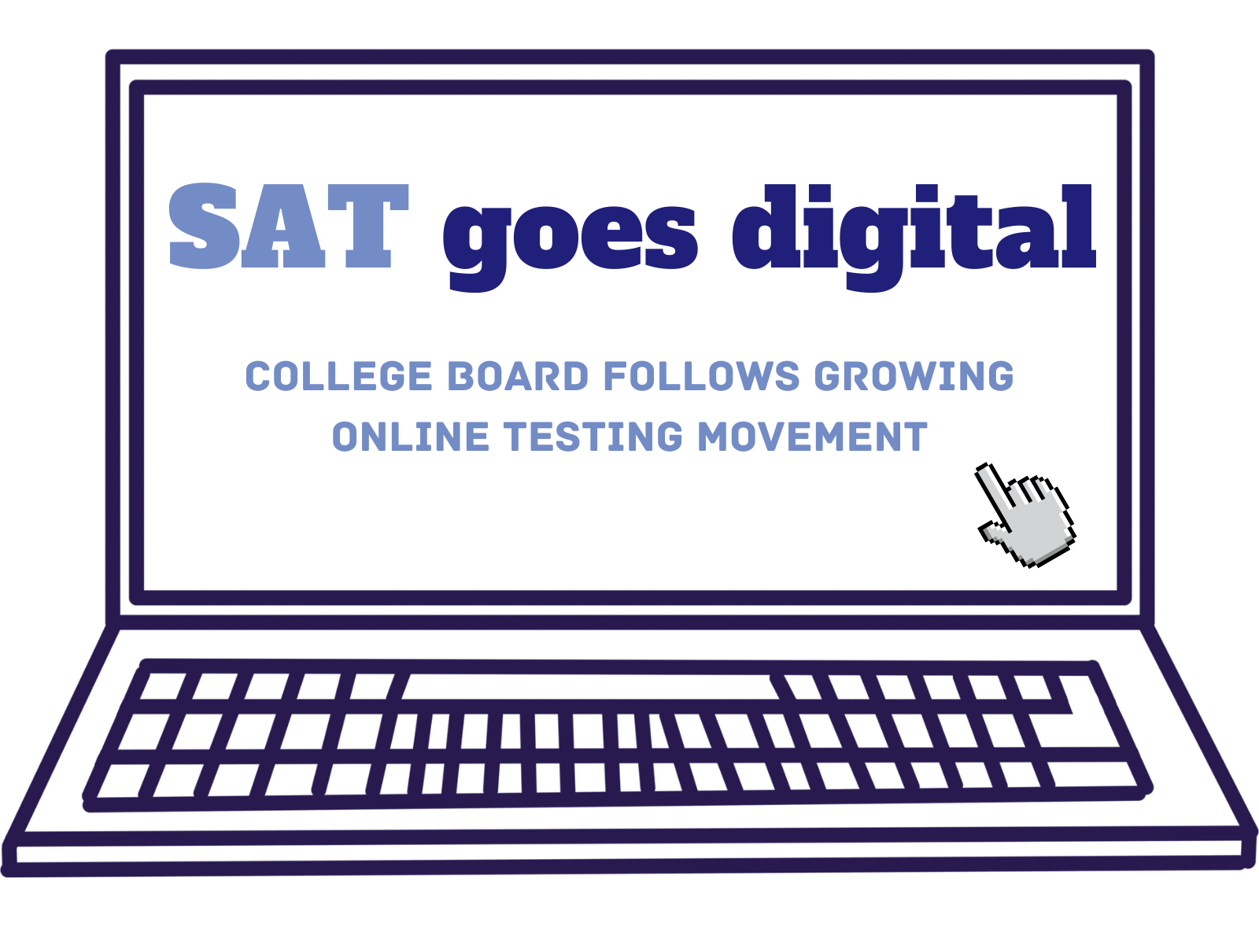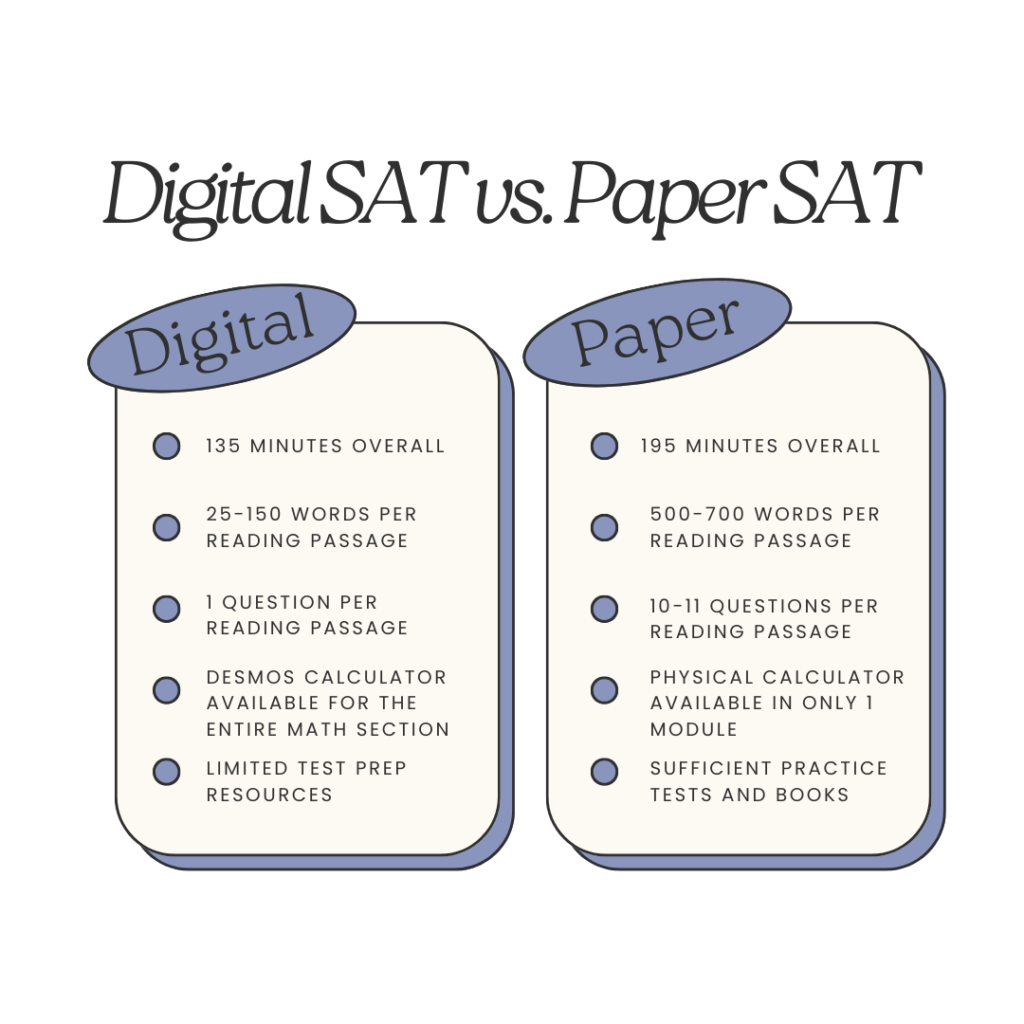
SAT goes digital
College board follows growing online testing movement
By: Valentina Padula and Erica Zuber
After nearly a century of a paper-based SAT, the exam will soon be replaced with a recent digitized version come Spring 2024. For an upcoming generation dependent on technology, this change may bring about more positives than shortcomings.
The newly computerized SAT has changed its original format in more ways than one, with differences observed in the total number of questions, overall time given on the exam and newly available testing features. Students must now bring an approved testing device with the College Board’s Bluebook application downloaded and set up before the testing day. For students lacking a laptop or tablet, they may request one from their school or College Board prior to the test. Within Bluebook itself, there are various tools available for students to access, such as an annotation tool, a help tool and an option to flag questions for later review.
Admission tickets may now also be approved through a picture, email or physical copy. These new, flexible elements could potentially make the high-pressure SAT a more seamless experience for students across the nation. The modified SAT has brought benefits to students and staff alike, with students appreciating the efficiency and comfort that online testing provides.

“I expect to prefer the digital SAT,” said senior Chris Pavia, who has taken the paper-based SAT and plans to transition to digital in the spring. “Students are more comfortable working online than on paper these days.”
For testing coordinator Jodi Tesser, the digitized version has revolutionized the testing process. Now lacking paper-based Scantrons and individually assigned answer packets, the initial setup and distribution of the exam have been significantly reduced. Testing materials and procedures are now strictly online, with set-up and clean-up in each testing room for proctors now being no longer necessary. Tesser experienced a considerable reduction in time and effort during the first run of the digital PSAT on Oct. 12. Despite having a few troubleshooting complications with a few students, Tesser could not comment on there being other issues with the testing process.
“I probably knocked a good five hours off of the prepping,” Tesser said. “I [previously] had to have a team in here and count every Scantron, every book and match up the serial number with the answer books. There was none of that [now] and so I think I am very much a fan of digital testing.”
College Board’s Bluebook application prevents students from accessing other browsers during testing time by utilizing a LockDown Browser feature. This aspect is similar to other standardized testing platforms, such as FAST, which also seek to prevent the possibility of cheating. Tesser, an avid supporter of testing integrity, approves of the LockDown feature for its ability to further secure academic honesty.
“This was very proactive on College Board’s end, having this safety feature in place,” said Tesser. “This will help eliminate any cheating that might have occurred had it been on a regular standard browser. The validity of the test could have been cowmpromised if they were able to bypass the browser.”
The SAT’s two sections, the Reading and Writing portion and the Math portion, have been modified, as well. Students are now able to access a digital or their personal calculator throughout both Math modules, where the device was previously only allowed on one specified module. The Math section’s total of 58 questions have been reduced to 44 questions with 22 questions in each module, which are each now 35 minutes long.
The Reading and Writing section has been narrowed down from its previous total of 96 questions to 54 questions, with each module having 27 questions. Where students formerly had 10-11 questions regarding a single passage, the digital SAT now has one question per a shortened passage. The time allotted for each section of the exam has been decreased, with the Reading and Writing section lowering its completion time from 100 minutes to 64 minutes and the Math section diminishing its former 80 minutes to 70 minutes.
“The test was a lot shorter and I liked how you could use your calculator for the entire math section, which personally made me go a lot faster,” said junior Alexis Perez, who took the digital PSAT. “I think there were less questions in general, so it was a lot quicker and it felt easier.”
College Board’s transition into a more digitized-based testing environment follows the trend of online learning that has taken over since COVID-19’s lockdown-induced classrooms. Similar to the SAT, College Board introduced digital-based AP exams available in 48 states for select AP subjects in May 2023. While the option is still readily available, local schools ultimately decide whether they remain paper-based for those eight AP courses. For the incoming flux of highschoolers, online testing has become an essential staple to their college readiness process.
“I think just because [the digital SAT] was a new system it kind of made it a little bit nerve-wracking,” Perez said. “Overall, I think it was pretty good but it was just the fact that it was something new that we have never done. It kind of made it a bit scary but I do think overall I like digital better.”


